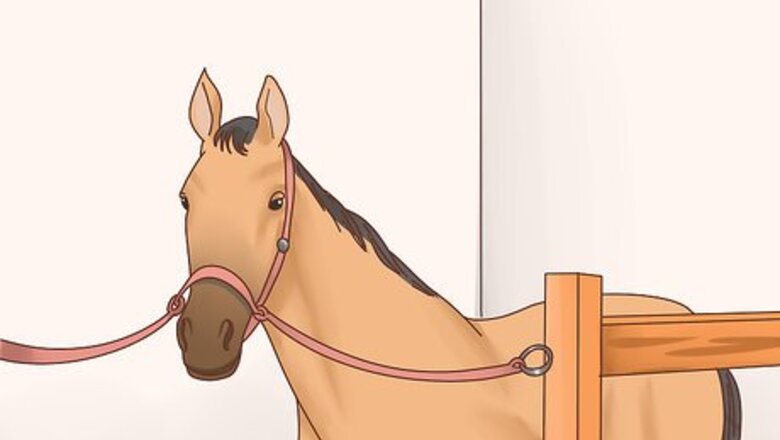
views
Grooming Your Horse
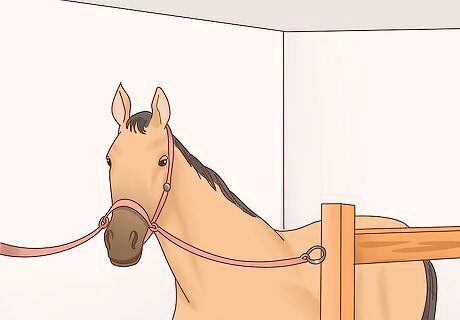
Lead your horse to the grooming area of your barn. You should have an area or separate stall outside of your horse’s regular stall where you groom her, if you do not have a specific area, then simply just tie her up with a lead rope outside her stall. Whether you have a specific area or not, it is essential that you tie it up, so it cannot get away while you groom. Wear some clothes that you do not mind getting dirty because grooming your horse can be a very messy job.
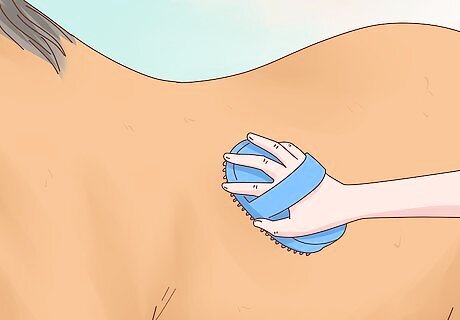
Use a rubber curry brush to loosen up the dirt on your horse’s coat. Move the brush in a circular motion over your horse’s body. To avoid injuring your horse’s more delicate skin, do not use the rubber curry brush on your horse’s face or legs.
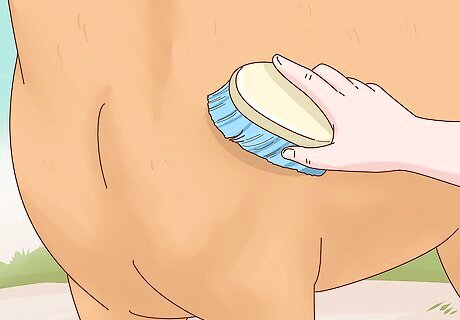
Use a dandy brush to remove dirt from the surface of your horse’s coat. With the direction of the hair, move the brush in rapid, short strokes, ending each one in a flicking motion to get the dirt off of your horse’s coat. You should see a cloud of dust come off from your horse’s coat each time you flick the brush. Make sure to use the flicking motion or the dirt will just stay on your horse’s body and may cause irritation. The Dandy Brush is very similar to the Body Brush but it is much rougher.
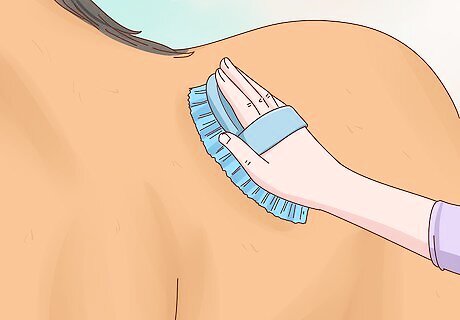
Use a body brush to smooth down your horse’s hair. Use long even strokes on your horse’s coat to smooth out her hair and get any remaining dirt off of her coat. This brush will help your horse’s coat look nice and shiny.
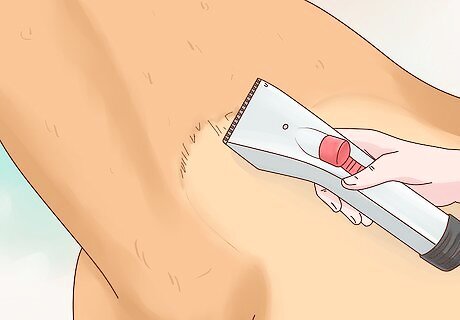
Use electric clippers to trim your horse’s body hair. If there are any areas of your horse’s coat that look like they need to be trimmed, use a pair of electric clippers to neaten them up. Don’t use the electric clippers on or around your horse’ face or you may startle her and even injure her. You don't need to clip your horse's coat every time you groom it. Wait until it has grown back. Make sure you clean the clippers after use. Never clip inside your horse's ears; the fur there protects them from dust and flies. You can clip the outsides of the ears. Doing this step is optional, however, it looks better for showing. Blanket your horse in the paddock when it is cold if you choose to clip its hair.

Use a mane comb to untangle your horse’s mane and tail. Be gentle and work through major tangles carefully using your fingers to avoid pulling out or breaking any hairs. You can also use the dandy brush on your horse’s tail to get it nice and soft. Don't brush your horse's mane and tail every day or it will become amazingly thin and it takes three years to regrow.

Clean your horse’s hooves. Stand next to your horse facing the horse's rump, and use one hand to bend and support your horse’s hoof. Use the hoof pick to remove any rocks, turf, or other objects that have lodged in your horse’s hoof. Scrape away from you so that you do not cause the objects in the hoof to fly towards your body or face. You should also have your horse's hooves trimmed every 3-8 weeks to keep them in good condition. Shoeing horses is not always necessary. In fact, some experts believe that shoeing can cause problems with the hooves rather than protect them.

Bathe your horse as needed. If your horse is looking extra dirty, you may want to give her a bath. Start by hosing down her body with warm water to rinse off excess dirt and prep her coat for shampooing. Then, massage shampoo into her coat using a curry brush and rinse. After you have rinsed out the shampoo, massage conditioner into her coat using the curry brush and rinse well. To avoid getting shampoo and conditioner in your horse’s eyes, use a wet washcloth to clean her face.
Feeding Your Horse
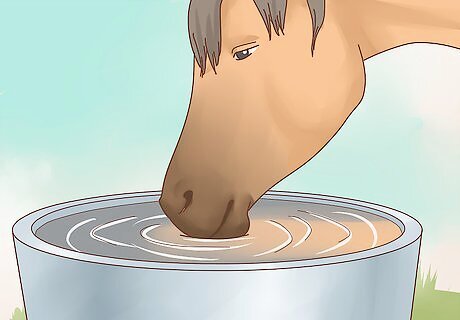
Provide your horse with plenty of water. Make sure that the water in your horse’s trough is clean and not frozen. Keep the trough clean as well by hosing it out every day.

Provide your horse with plenty of good quality hay. Horses eat large quantities of grass as their main source of food. In fact, horses should eat about 15-20 pounds or 1-2% of their body weight in hay every day, so make sure that your horse always has plenty of hay to eat. Make sure that the hay you feed your horse is free of mold and dust.
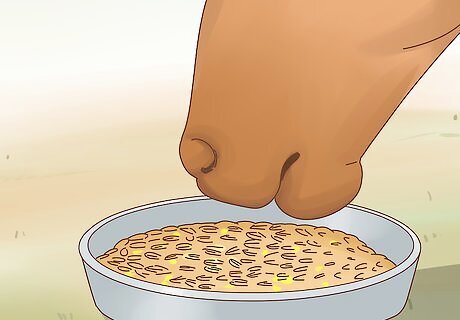
Provide small amounts of grain to your horse throughout the day. Every day, horses can also have a ½ pound of grain per 100 pounds of body weight. Feed grain to your horse in two or three evenly spaced feedings during the day. Make sure to measure the grain portions that you feed your horse to make sure that you are giving her the correct amount. If the weather is hot, feed grain to your horse during the cooler hours of the day, such as early in the morning and later in the evening.
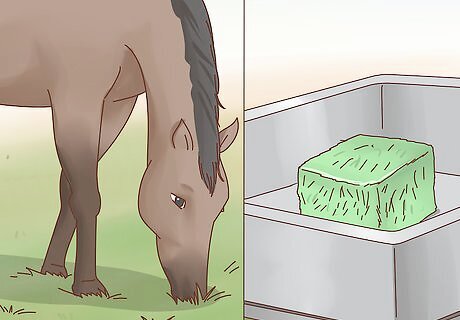
Provide more or less food for your horse as needed. Your horse’s nutritional needs will vary according to the amount of fresh grass she has consumed while out to pasture and the level of activity she has had. Evaluate your horse’s needs daily to determine whether to subtract or add from her regular feeding amounts. If your horse has been out to pasture all day and has been eating lots of grass, she will not require as much hay. If your horse has had a hard work day with lots of riding, then you will need to provide more food to help replenish the extra calories she burned.
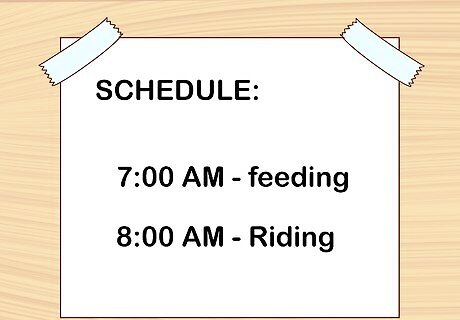
Schedule feedings for an hour before or after you have ridden your horse. Don’t feed your horse right before or right after she has finished doing something strenuous because blood flow will be diverted away from her organs and that can interfere with digestion. Plan feedings around your horse’s scheduled activity. If your horse will be doing something extra strenuous, schedule her feeding for three hours before the activity.
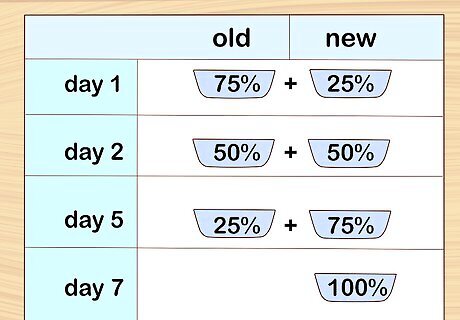
Make gradual changes to your horse’s diet. If you need to change your horse’s feed, do not just switch to the new feed. Start by replacing 25% of the old feed with the new feed. In two days, replace 50% of the old feed with the new feed. Two days after that, replace 75% of the old feed with the new feed. Then two days after that you will be able to give your horse 100% new feed. In addition to making food changes gradually, you should also feed your horse at about the same time every day. Horses perform better when they have a regular feeding schedule. Making drastic changes to your horse’s feed or feeding schedule can lead to equine colic and founder. Equine colic is a condition that causes severe abdominal pain and may even require surgery. Founder is a condition that causes poor circulation and can even lead to the separation of the hoof from the foot. Founder is often fatal.
Bonding with Your Horse
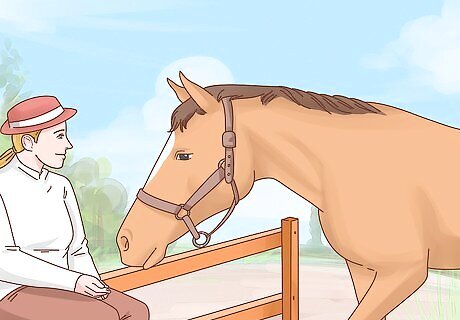
Hang out with your horse and let her approach you. Take some time now and then to just sit still in the paddock (on the fence or in a chair, not on the ground) and let your horse approach you on her own terms. As you sit, pay attention to your horse’s behavior to see what she’s like when she is not working for you. By taking time to just be a presence in your horse’s environment, you will gain her trust and learn more about her personality.

Approach your horse with slow gentle movements and a calm demeanor. Instead of walking straight up to your horse, throwing the saddle on, and going for a ride, slow down a bit. Let your horse sniff your hand and talk to her. Taking time to slow down and be a calming presence will help improve the trust between you and your horse.
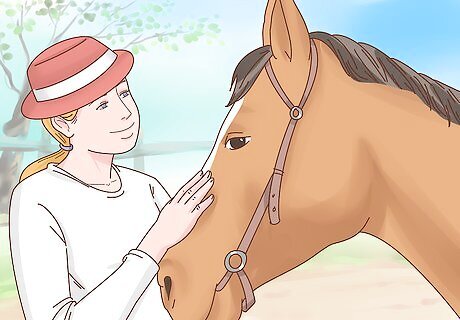
Pet your horse. Take time to pet your horse to let her know that you appreciate her. Massage her ears, scratch her neck, and pat her head. Learn where your horse likes to be pet and make it a daily part of your interactions. Some horses are ear-shy and don't enjoy their ears being touched.
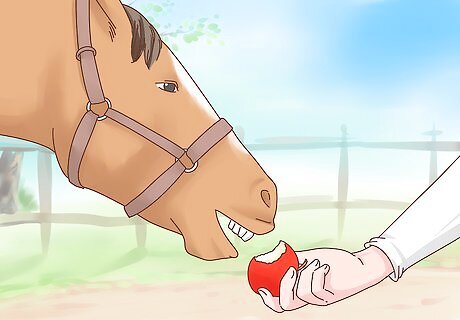
Give treats in moderation. Giving treats to your horse when you want to reward her is a great way to bond with your horse as well. Just make sure that you do not overdo it with treats or your horse may learn to expect them or may even try to root around in your clothes for treats. Fresh apples and carrots make great treats for your horse.
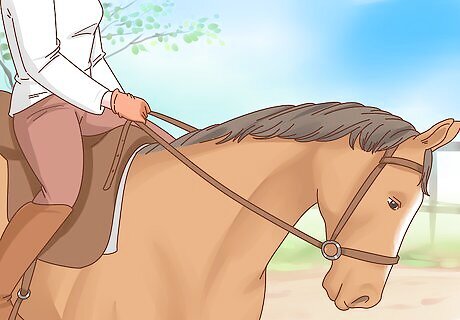
Encourage neck drops. Neck drops are a horse’s way of demonstrating trust or submission. If your horse is willing to drop her neck in your presence then you have a good bond. To get your horse to drop her neck, tug gently on the lead rope below your horse’s head. If your horse does not yield, then keep building your bond and try to request a neck drop some other time.
Training Your Horse
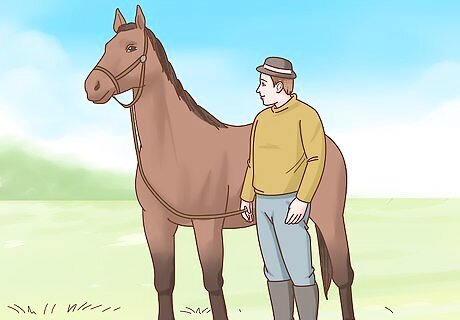
Follow basic rules for safety when training your horse. Every interaction that you have with your horse in an opportunity to teach her something. Make the most of these moments and stay safe by following some basic rules for safety around your horse. Never stand or walk directly behind or in front of your horse. When working with your horse’s head, stand on your horse’s left side at an angle from her head. Talk to your horse and touch her body as you move out of her field of vision. When you need to do something with your horse’s hoof, bend over rather than crouching down.
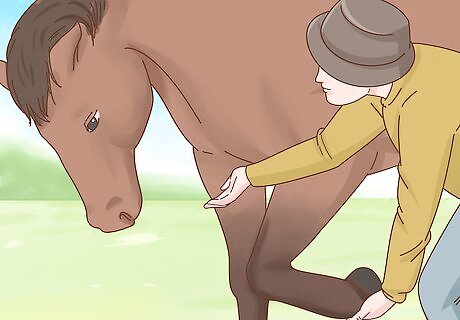
Go slow. Your horse will not be able to learn a new trick or command in just one day. To teach your horse new things, you will have to take it one step at a time. Break the training goal that you have for your horse into smaller goals and work towards those goals one at a time. For example, if you want to teach your horse to bow, start by teaching her how to follow a target with her nose first.

Be patient with your horse. Trying to teach your horse or dealing with misbehavior can be aggravating, but you need to keep calm. Your horse may become frightened or frustrated if you seem angry or upset, so it is very important for you to remain calm and positive even if your horse is not responding well to what you are trying to teach her.
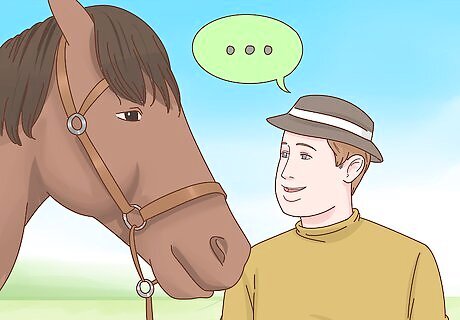
Talk to your horse in a soft, low tone voice. Never yell or use a high-pitched voice around your horse or you may frighten her. Instead, speak to your horse in a soft, low tone voice to help keep her calm and responding to your instructions.
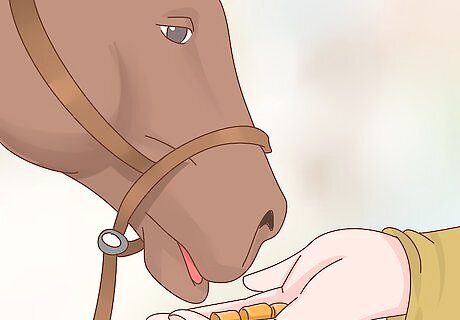
Use positive reinforcement. Make sure that you acknowledge your horse’s accomplishments by using positive reinforcement when she does what you have asked. Treats are the most common form of positive reinforcement. Positive reinforcement will help your horse understand that she is on the right track.
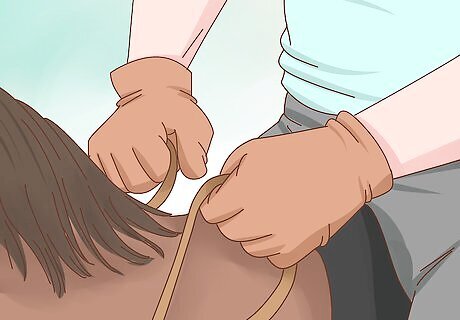
Use negative reinforcement. Applying gentle pressure with the reins or using a gentle whip tap can be used as negative reinforcement. Continue to apply the negative reinforcement until your horse does what you have asked. Make sure that you do not use any type of negative reinforcement that frightens or hurts your horse. The negative reinforcement should not be frightening or painful, just annoying.
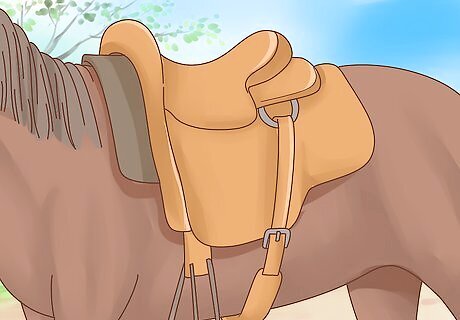
Use a good quality saddle when you ride your horse to get the most out of your training session. If your horse is not comfortable, then she may be distracted when you try to give commands. Make sure that your horse’s saddle is fitted to her body and that the quality is high enough to prevent her from getting sores. Using padding under a cheap saddle will not solve the problem, your horse will still be uncomfortable. Expect to spend upwards of $500 for a good quality saddle. If you have more than one horse, you may need a different saddle for each one.
Keeping Your Horse Healthy

Schedule regular veterinary exams. Schedule regular physical and dental exams with your veterinarian to make sure that your horse is healthy and up to date on her vaccinations. Common vaccinations include tetanus, eastern and western equine encephalomyelitis, equine influenza, rhino pneumonitis (equine herpes), and rabies. Your horse will also need to be dewormed regularly. Horse teeth continue to grow as they age. Eating grass and hay helps to grind down your horse’s teeth, but it is still important to have a dentist check for any signs of rotting or other dental problems that may be causing your horse discomfort.
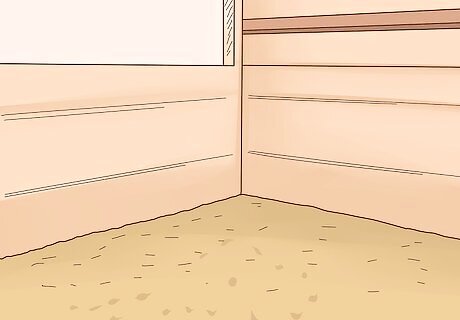
Make sure that your horse has room to lay down in her stall. Horses can sleep standing up, but they need to lay down to get deep sleep. Keep your horse’s stall clean so that she will be able to lay down without getting filthy.
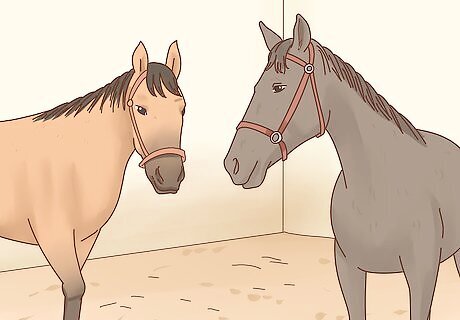
Socialize your horse. It is important for horses to be with other horses. Make sure that your horse has a companion or two that she can interact with on a regular basis. If possible, let your horses see each other in their stalls.
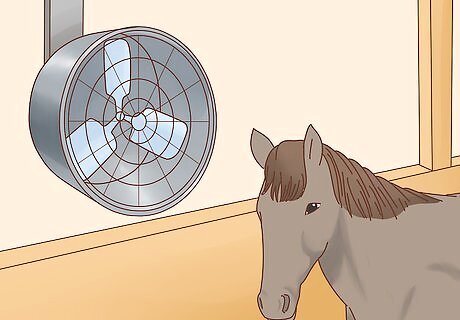
Protect your horse from extreme weather conditions. It is important to make sure that your horses are warm enough in the winter, but cold does not bother horses as much as the heat. Horses cannot get rid of excess heat in their bodies except by sweating, so use extreme precaution in the summer. Do not make your horse do anything strenuous in hot weather.
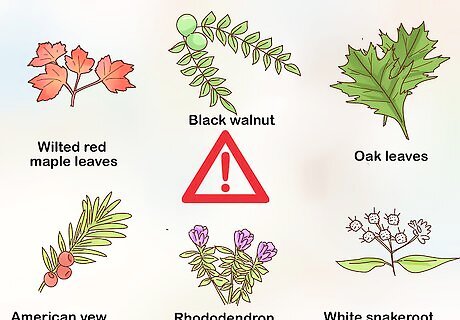
Be aware of plants that are hazardous to horses. If you think that your horse may have been poisoned by something she ate, call your veterinarian or ASPCA Animal Poison Control Center's 24-hour hotline at (888) 426-4435 right away. There are several species of plants and one species of beetle that can poison your horse if she ingests one of them. Potential hazards to your horse include: Wilted red maple leaves Black walnut Oak leaves Taxes species (yew, Japanese yew, American yew, English yew, western yew, oleander and rose laurel) Rhododendron and azalea White snakeroot, richweed, white sanicle, jimmy weed, rayless goldenrod, burrow weed Yellow star thistle, St. Barnaby's thistle, Russian knapweed Blister beetles (sometimes found in alfalfa hay, especially in the Midwest and Southwest) Ragworth/Ragweed




















Comments
0 comment